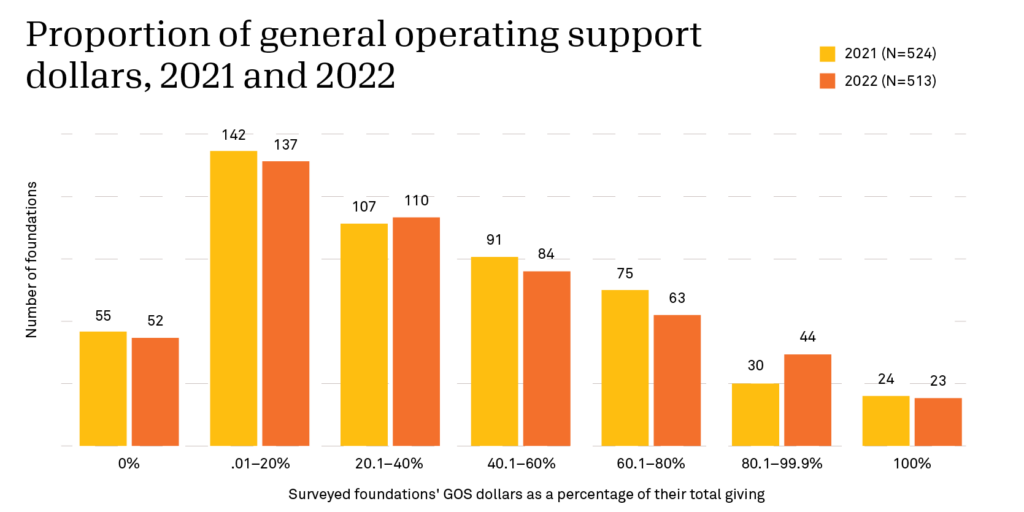4 things we learned about foundations and general operating support

Most nonprofit fundraisers consider general operating support (GOS) to be the holy grail of nonprofit donations. Funding an organization’s mission rather than a specific project or purpose, this unrestricted financial support provides vital flexibility for nonprofits to approach their work as they best see fit. For years, nonprofit leaders have called on funders to give more general operating support. In the wake of COVID-19 and movements for racial equity, foundations also committed to making grants as unrestricted and flexible as possible.
Every year, Candid surveys large U.S. private and community foundations to learn more about giving trends.i This year, we asked survey respondents to share how much of their total giving in fiscal year end 2021 and 2022 was awarded as general operating support. They could provide this as an estimated dollar amount or a percentage of their total grant payments.
Here are four things we learned about GOS grantmaking trends among funders right now.
1. Funders don’t always track their GOS grants
Survey respondents expressed difficulty in estimating the dollar amount for their general operating grants. Some commented that they were sharing a “very rough number” or a “best guess.” Others were unable to provide even an estimate since they don’t track GOS grants. A few community foundations explained that they reported GOS dollars from their discretionary grants only, as they do not track types of support for grants made from donor-advised funds.
2. Most funders awarded some general operating support
Of 513 survey respondents, 90% reported that they awarded at least some GOS dollars in 2022. (In 2021, this figure was nearly the same, 89%). About 10% of foundations indicated they awarded no GOS grants whatsoever. Grantmaking missions and strategies may, in part, explain why a foundation doesn’t provide GOS. For example, respondents commented that their grantmaking purpose is focused solely on capital projects and/or academic scholarships. On the other hand, some foundations reported that the entirety of their grants were for general operating support. These funders represented less than 5% of respondents.
3. For the median foundation, a third of grant dollars was for GOS
Funders gave anywhere from 0% to 100% of total grant dollars as general operating support. The median foundation in 2022 awarded 32% of total grant dollars as GOS. In 2021, the median was 30%.ii

Most foundations maintained the same level of GOS from 2021 to 2022. Several foundations reported that the COVID-19 pandemic inspired more general operating grants in 2021. Subsequently, in 2022, they indicated their level of general operating support declined. Overall, however, GOS funding remained relatively stable from 2021 to 2022.
4. Foundations don’t share the same definition of general operating support
Foundations surveyed were also invited to add comments about their general operating grants. Through this feedback, we discovered some inconsistencies in how funders understand and count general operating dollars. Here are a few responses that illustrate this dynamic.
- “General operating support? I take that this means anything but endowment giving, even if directed to support a particular program within the charity, as we often do.”
- “Internally, there is a lack of clarity about what general operating support exactly means.”
Foundations may be flexible in their funding approach, even if it isn’t in the form of general operating support. Respondents described unrestricted support for programs or funds. In some cases, respondents may have counted these grants in their GOS figures.
- “[Reported figure] represents dollars granted as flexible funding (general operating and general program support), roughly two-thirds of our funding.”
- “Support for programs is essentially support for operations in many of the ways the requests were written…”
- “A majority of our annual funding each year is either for general support (unrestricted for the entire org) and/or “core” support (unrestricted for a specific program or project at a larger institution), in addition to project-restricted grants. We usually express our metric to include both “general” and “core” as our total “unrestricted” support, but for this survey, we are only providing the strictly “general” support payments.”
In our data analysis, we included all reported GOS figures, regardless of the additional comments. But it’s evident that foundations’ definitions and considerations of general operating support vary.
The terms “unrestricted funding,” “flexible funding,” “core support,” and “general operating support” are sometimes used interchangeably in the sector. Since GOS is frequently referenced—in conference sessions, webinars, and reports—perhaps a much needed first step is to be clear about what it is and why it matters. Here are a few things for funders to keep in mind about general operating support:
- GOS is organizational support, not program support. GOS is unrestricted funding for an organization’s overall mission. No matter how flexible, if a grant is for a specific program or fund within the organization, it isn’t GOS.
- Nonprofit leaders say that GOS grants have the most impact on strengthening their organizations. Multi-year GOS is preferable but occurs more rarely.
- Misconceptions about GOS may be limiting foundations from providing GOS. Beliefs, such as “general operating support grants are not as accountable as restricted project grants,” can be corrected.
Foundations, regardless of their size, can learn from their peers to better understand GOS, align on a standard definition, and increase GOS to further nonprofit partners’ ability to drive impact.
Our thanks to the foundations that participated in this year’s Foundation Giving Forecast Survey. We conduct this survey annually and welcome feedback on what you’d like us to ask in 2024. Please share your ideas in the comments section.
i About the survey: From January through March 2023, Candid sent an online survey to roughly 2,500 of the largest U.S. private and community foundations by total giving. The survey focuses on large foundations because they account for the vast proportion of grant dollars awarded. In all, 602 funders responded: 421 independent foundations, 132 community foundations, 47 corporate foundations, and two operating foundations. Annual giving figures and survey responses are based on the fiscal year end. Roughly 520 respondents provided estimates of their GOS grants, either as a dollar amount or a percentage of total grant payments.
ii These figures should not be compared with other statistics about general operating support, as the methodology may be different. For example, according to the Center for Effective Philanthropy (CEP), in the decade prior to the COVID-19 pandemic, 21% of grants were for GOS. Candid’s U.S. Social Sector Dashboard indicates that in 2019, 23% of private and community foundation grant dollars were designated as general operating support. This analysis, however, is based on each surveyed foundation’s estimate of GOS dollars as a proportion of their total grant dollars.







